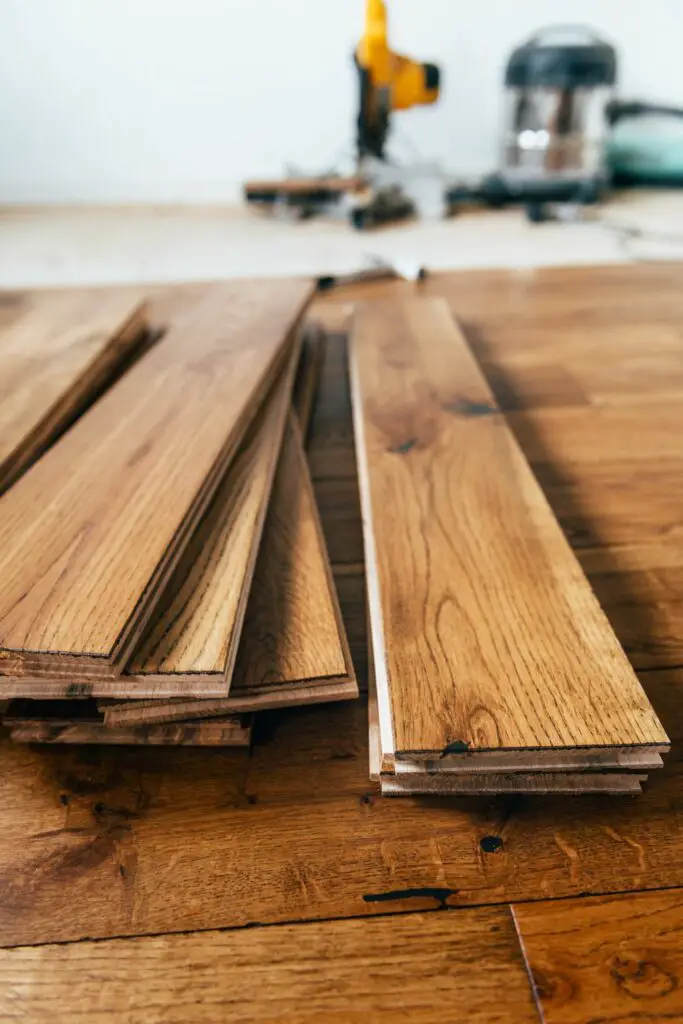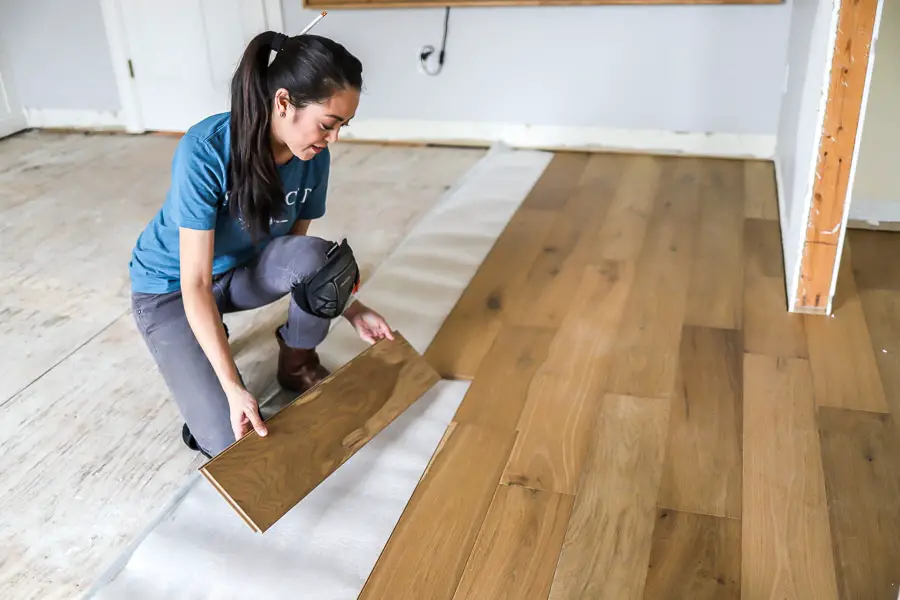Table of Contents Show
Deciding between solid wood and engineered wood when choosing a sofa is a common dilemma among homeowners and design enthusiasts. The journey of selecting the right furniture for your living space is often exciting yet peppered with moments of uncertainty.
Both materials have made a name for themselves in the furniture world, but which one takes the crown when it comes to the perfect blend of beauty, reliability, and cost-effectiveness for your sofas? As someone who has spent considerable time reimagining spaces and bringing countless home visions to life, I understand the importance of this decision.
You’re not just choosing a piece to fill a space; you’re investing in comfort, aesthetics, and a piece that ideally, will weather the years alongside you. In my years as a contractor, the debate between solid wood and engineered wood furniture, especially in the realm of sofas, has been as enduring as the materials themselves.
Solid wood boasts a legacy in furniture craftsmanship; it’s the traditional hallmark of quality, offering natural grains and a unique finish. On the other side, engineered wood has emerged as a modern contender, known for its versatility and resistance to certain environmental drawbacks that affect solid woods, such as humidity changes.
In this comprehensive comparison, we’re putting solid wood and engineered wood sofas under the spotlight, assessing everything from design potential and durability to comfort and cost.
Quick Answer
The main difference between solid wood and engineered wood sofas lies in their material composition, durability, aesthetic appeal, and cost implications. Solid wood sofas, renowned for their robustness and unique, natural patterns, offer a higher-end, luxurious choice and tend to have a lengthier lifespan, justifying their upfront investment. In contrast, engineered wood sofas provide a cost-effective, versatile, and environmentally adaptable alternative, with a range of stylish options suited for modern decor. When considering “which is better,” homeowners should assess their budget constraints, design preferences, and household needs to determine the most suitable option.
What Are Solid Wood and Engineered Wood?

When it comes to selecting the prime material for your sofa, understanding the fundamental differences between solid wood and engineered wood is essential. These materials aren’t just different in name; they possess unique characteristics, manufacturing processes, and aesthetics that significantly influence their performance and appeal in furniture, especially sofas.
Starting with solid wood, this material is renowned for its robust nature and aesthetic supremacy, derived directly from timber.
Solid wood is essentially lumber that has been cut from a tree and then processed into slabs and pieces convenient for furniture construction. Its natural origin means that each piece boasts unique patterns, grains, and textures, contributing to the distinctiveness of every solid wood sofa.
Popular types of solid wood utilized in sofas include oak, known for its remarkable strength; maple, which is revered for its durability and natural beauty; and cherry, often chosen for its rich color and smooth grain.
According to a study published in the journal “Forests,” solid wood furniture, like sofas, provides not just aesthetic pleasure but also significant durability. The research emphasizes that solid wood, being a natural and renewable material, possesses hypoallergenic properties, contributing to healthier indoor air quality, aside from its well-recognized longevity and minimal need for maintenance.
On the other hand, engineered wood is a more recent innovation in the woodworking and furniture industry. It’s manufactured by binding or fixing the strands, particles, fibers, or veneers of wood, together with adhesives, to form composite materials.
Unlike solid wood, engineered wood such as plywood, medium-density fiberboard (MDF), and particleboard, are engineered to precise design specifications and are tested to meet national or international standards.
This manufacturing process ensures a certain uniformity in its makeup and appearance, providing versatility and resistance to environmental factors that typically affect solid wood.
Plywood is a popular type of engineered wood for sofas, prized for its strength and resistance to cracking, shrinking, and warping. MDF follows closely, offering a smoother surface. In contrast, particleboard is an economical option, providing a commendable balance between cost and performance.
Aesthetics and Design Potential
Embarking on the journey of choosing the perfect sofa often leads us to the crossroads of aesthetics and functionality. In the realm of design, the material of your sofa becomes the silent ambassador of your style, silently contributing to the ambiance and comfort of your living spaces.
When we compare the design potential between solid wood and engineered wood sofas, the distinctions pivot around their natural grain beauty, finish, and the creative liberties these materials afford to craftsmen and homeowners alike.
Solid wood is synonymous with a classical appeal and luxurious touch, often the go-to choice for “luxury solid wood sofa designs.” The charm of solid wood lies in its natural grain patterns, each telling a unique story.
The individual history of every wood slice, with its knots, color variations, and depth, adds an unparalleled richness to the furniture. This aspect means that no two solid wood sofas are ever genuinely identical, appealing to those who treasure individuality and organic beauty in their decor.
Furthermore, the finishing possibilities with solid wood are vast. Whether it’s the subtle sophistication of a stain that enhances the wood’s natural tones or a glossy sealant that protects and accentuates the grain, solid wood finishes contribute significantly to the vibe of a space.
This material has a natural affinity for carving, allowing for intricate designs and detailing on sofa frames, which stands as a testament to craftsmanship and artistry.
Conversely, engineered wood offers a different kind of aesthetic palette, often aligning with “contemporary engineered wood sofa styles.” Engineered wood levels the playing field with a more consistent and uniform appearance, free from the unpredictabilities of natural wood grain.
This consistency makes it a favorite in modern, minimalist designs where uniformity and sleekness are desired. It’s particularly adaptable to various styles and hues, enabling designers to cater to a wide spectrum of interior décor themes.
The visual design flexibility of engineered wood also shines in its compatibility with various finishes and paints, absorbing colors evenly, which is often a challenge with solid wood varieties. This trait allows for a more predictable and controlled design outcome, ensuring that the envisioned aesthetic can be achieved with precision.
In essence, the choice between solid wood and engineered wood sofas does not rest solely on their durability or cost but extends into the realm of design potential.
Whether you’re captivated by the timeless elegance of natural grains or you’re steering towards the versatility and contemporary sleekness of engineered materials, recognizing your own design preferences will guide you toward making a choice that resonates with your living space’s overall style and vibe.
Durability and Longevity: Which Sofa Lasts Longer?
One of the paramount factors when investing in a new sofa is its durability and longevity. The assurance that your chosen piece can withstand the tests of time and use is invaluable. Both solid and engineered wood sofas are popular choices in households, yet they present different perks and considerations in terms of lifespan.
Understanding these can help answer pressing questions homeowners often face, such as “How long does a solid wood sofa typically last?” or “Is an engineered wood sofa durable?”
Solid wood furniture is often celebrated for its strength, a key factor contributing to its impressive durability.
Crafted from single pieces of lumber, solid wood sofas have the innate robustness of their originating trees, allowing them to bear significant weight and resist physical impacts to a certain degree. This resilience often translates into a longer lifespan, with many solid wood pieces being passed down through generations.
However, this material’s durability is influenced by its need for consistent maintenance, especially in environments susceptible to humidity and temperature fluctuations. Without proper care, solid wood can be prone to warping, cracking, or rotting, compromising its structural integrity.
Regular polishing, timely repair of any damages, and keeping the sofa away from direct sunlight or heating sources help preserve the natural robustness of the wood.
Conversely, engineered wood sofas offer a different set of durability characteristics. Engineered wood, especially high-quality variants, can resist warping and cracking because of the way they’re constructed.
Layers of wood veneers or fibers are bonded with adhesives under high pressure, creating a stable, uniform composite less susceptible to environmental changes. This stability is a boon for households in areas with significant seasonal climate shifts, answering the common query: “Does engineered wood sofa last?”
Yet, it’s critical to note that not all engineered wood is created equal. The longevity heavily depends on the manufacturing quality, including the types of adhesives used. Some engineered wood may be vulnerable to moisture, leading to swelling or deterioration over time, particularly if the sofa is situated in a humid area or prone to spills.
Regular cleaning, immediate attention to stains, and the use of dehumidifiers can be integral to maintaining the sofa’s condition.
Comparatively, both materials present viable options in different scenarios. If you prefer a sturdier, more traditional feel and are committed to maintenance, solid wood sofas could be your ally for a lifetime.
However, if you’re looking for a more adaptable solution requiring potentially less maintenance, engineered wood sofas could be the answer, especially in homes where conditions might not be favorable for solid wood.
In conclusion, the lifespan of your sofa, whether solid wood or engineered, hinges not only on the material but also on the care it receives. Making an informed decision involves balancing the aesthetic desire, usage demands, and environmental factors specific to your home.
Comfort and Daily Use
When investing in a new sofa, comfort is as paramount as its aesthetic appeal and durability. After all, this piece of furniture is where you and your loved ones will spend significant time relaxing.
As we delve into the comfort offered by solid and engineered wood sofas, it’s essential to shed light on their construction, stability, and how these aspects influence their suitability for daily use. This analysis is crucial for homeowners grappling with decisions centered around queries like “What is the most comfortable sofa material?”
Solid wood sofas are often associated with sturdiness and a certain robust feel, attributed to their construction from dense, natural lumber. This very solidity, while being a marker of quality and durability, plays a significant role in comfort.
The design variance in solid wood sofas allows for a range of comfort levels. For instance, a hand-carved solid oak sofa might have a firmer feel, suitable for those who need support for their posture.
However, it’s the craftsmanship where solid wood truly shines. The ability to customize designs means you can have sofas with ergonomically curved backrests, well-measured seat depths, and appropriate angles for maximum comfort.
The addition of high-quality cushions and upholstery further enhances the comfort level, making solid wood sofas versatile for various relaxation and seating preferences.
In contrast, engineered wood sofas bring different comforts to the table. These sofas stand out for their consistency and stability, owing to common manufacturing standards. Engineered wood allows for uniformity and precision in construction, eliminating the slight variances that might occur in solid wood pieces.
This uniformity can contribute to an even level of support throughout the sofa frame, providing a consistent sitting experience.
Moreover, engineered wood tends to be lighter than solid wood, allowing for more innovative and user-friendly designs, especially for homes where furniture might need to be moved regularly.
The flexibility in design means manufacturers can prioritize comfort, creating sofas that cater to a wide array of ergonomic needs. When paired with plush cushions and tailored upholstery, these sofas can easily compete with their solid wood counterparts in the comfort department.
Addressing the question of the “most comfortable sofa material” is not straightforward, as comfort is subjective. It relies heavily on individual preferences and lifestyle needs. Some may prefer the firm, reliable support of a solid wood sofa, while others might lean towards the softer, more adaptable comfort offered by engineered wood options.
Ultimately, the key lies in understanding your comfort preferences and considering them alongside the material characteristics before making this important investment for your home.
Cost Implications
Deciding on a new sofa for your home isn’t just about comfort, style, or durability; it also involves budgeting. When comparing solid wood and engineered wood sofas, understanding the cost implications of both options is crucial.
This consideration often leads potential buyers to search for the “cost of solid wood sofas” or look up “affordable engineered wood sofas,” seeking a balance between quality and affordability.
Solid wood sofas are often situated at a higher price point in the market. The cost is reflective of several factors: the quality of the timber, craftsmanship, and the furniture’s longevity.
Species of wood like oak, mahogany, or teak are especially prized for their durability and classic aesthetic appeal, but they come with a steeper price tag. Moreover, solid wood furniture is often handcrafted, adding to the labor costs due to the intricate work involved.
However, when purchasing a solid wood sofa, you’re investing in a piece of furniture that can last for decades, if not generations, with proper care. While the upfront costs might be high, the long-term investment is sound, considering you may not need to replace the sofa for many years, thereby saving costs in the long run.
On the other side of the spectrum, engineered wood sofas are often more budget-friendly, making them appealing options for those seeking style and comfort at a more accessible price point.
The affordability is due in part to the materials’ standardized manufacturing process, which typically requires less manual labor, and the use of composite wood materials, which are cheaper to produce than solid wood.
However, it’s important to note that while you might save on initial costs, some engineered wood sofas may not have the same lifespan as solid wood. The need for potential replacements should be factored into your budgeting.
Additionally, the price can vary significantly based on the quality of the engineered wood, the construction method, and the brand. Higher-end engineered wood can offer greater durability and aesthetic appeal but at a cost closer to solid wood pieces.
In evaluating the short-term versus long-term investment, solid wood sofas win the longevity game, making them cost-effective over time, despite the higher initial investment. Engineered wood sofas, while generally more affordable upfront, may incur additional costs down the line due to replacement needs, depending on the quality purchased.
Ultimately, assessing your budget means considering not just the purchase price, but also maintenance and potential replacement costs. By understanding these aspects, you can make an informed decision that aligns with your financial comfort zone and your desire for quality and longevity in your next sofa.
Deciding Which is Better for You

Navigating the decision between solid wood and engineered wood sofas involves juggling various factors, each significant in shaping the comfort, appeal, and functionality of your living space. Throughout this discussion, we’ve uncovered that both materials bring unique strengths to the table.
Solid wood captivates with its timeless charm, inherent durability, and the warm, natural vibe it adds to your home. Engineered wood, on the other hand, stands out for its modern aesthetic flexibility, generally friendly price point, and commendable stability, especially in fluctuating environments.
Your budget is a crucial determinant, undoubtedly. While solid wood sofas are a premium choice often reflected in their price, they’re also a long-lasting investment, potentially serving you and future generations with minimal need for replacement.
Engineered wood offers immediate financial relief, a boon if you’re mindful of current budget constraints, but it’s wise to factor in the potential for more frequent replacements or repairs.
Aesthetic preferences play an equally compelling role. Are you drawn to the authentic, unique patterns and the sense of luxury solid wood exudes? Or do you prefer the sleek, uniform, and contemporary flair that engineered wood can provide? Your sofa is a centerpiece, and its harmony with your interior ambiance is an aspect that cannot be downplayed.
Moreover, let’s not overlook functional requirements. Assess your living situation, the climate of your region, the presence of children or pets, and your lifestyle. These factors are pivotal in determining which sofa type will stand the test of time in your household.
In conclusion, deciding on the “better” material for your sofa is a deeply personal verdict. It’s not solely about the cost, the style, or even the durability in isolation. Instead, it’s about finding the sweet spot that marries your financial comfort, your style desires, and your practical needs.
Take a moment to reflect on both the immediate allure and the long-term implications of your choice. By doing so, you’ll invest in a piece that’s not just furniture, but a space of comfort, a spot for daily unwinding, and a cornerstone of countless memories to come.













